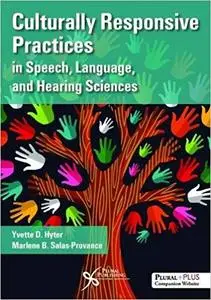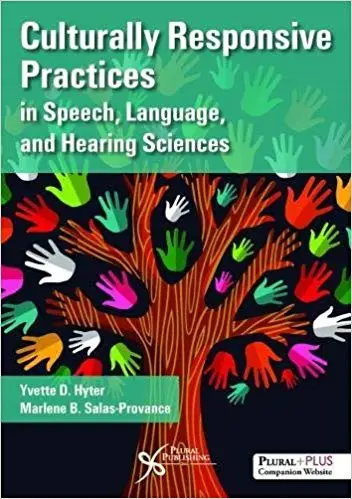Culturally Responsive Practices in Speech, Language, and Hearing Sciences
Plural Publishing | English | 2019 | ISBN-10: 1597568678 | 350 pages | PDF | 9.35 MB
Plural Publishing | English | 2019 | ISBN-10: 1597568678 | 350 pages | PDF | 9.35 MB
by Yvette D. Hyter (Author), Marlene B. Salas-Provance (Author)
Culturally Responsive Practices in Speech, Language, and Hearing Sciences is the only textbook that provides an innovative perspective on cultural competence in the field of communication sciences and disorders. It is imperative for speech-language pathologists and audiologists to be aware of diverse aspects of globalization, how these aspects may affect their own knowledge, strengths and biases, service provision, their clients lives, as well as their clients relationships to service providers. The purpose of this text is to facilitate the creation of knowledge, and the development of attitudes and skills that lead to culturally responsive practices.
The text presents a conceptual framework to guide speech-language pathologists and audiologists towards cultural competence by becoming critically engaged users of culturally responsive and globally engaged practices. The text is focused on speech-language pathology and audiology, but also draws from theoretical frameworks in other disciplines for an inter-professional, transdisciplinary and macro practice perspective, and would be appropriate for other allied health professions. This information will help students and professionals build their own conceptual framework for providing culturally and linguistically responsive services, and to engage with others globally.
Key Features:
Case studies to facilitate students and professionals knowledge and skills regarding culturally and linguistically responsive practices
Journal prompts and discussion questions that challenge individuals to use critical and dialectical thinking
Real-life activities that can be completed inside or outside the classroom or therapeutic setting
Suggested readings from the current literature in cultural and linguistic responsiveness, cultural competence, and global engagement in order to build knowledge and skills, and to affect student attitudes
A PluralPlus companion website with supplementary resources for students and instructors. For students the website includes study guides for each chapter, flashcards for concepts used throughout the text, and suggestions for additional readings. For instructors the website includes PowerPoint lecture slides outlining chapters and learning activities to use with students, designed to support class preparation and teaching the content in the text. Such learning activities include:
Case studies including decision making and planning for culturally responsive assessment and intervention processes
Journal prompts designed to strengthen critical and dialectical thinking
Identifying challenges and proposing solutions to providing culturally responsive speech-language pathology and audiology services
Exercises to facilitate clinical observations, ethnographic interviewing skills, and working with an interpreter
This textbook is intended for courses on cultural competence in speech-language pathology and audiology programs. It is also appropriate for general multicultural courses in speech-language pathology and audiology, and such courses in allied health programs. Students in speech-language pathology and audiology programs are required to gain knowledge and skill competencies pertaining to culture, cultural competence, cultural bases of normal and impaired communication development, cultural correlates of various developmental and disordered categories, and cultural/linguistic backgrounds and influences of clients and their families. This textbook may also be used as supplemental material in language acquisition courses in communication sciences and disorders programs, and in special education courses that teach special education teachers about working with children who have communication disorders.
Review
The content matter is not only accurate but a much-needed addition to coursework in communication disorders. Too often information presented about diversity is from a deficit perspective or a checklist about working with diverse families based on race or ethnicity.
The information presented is an excellent way to infuse multicultural/diversity into every aspect of classes on communication and communication disorders.
There is not another text like this for our field. I would definitely recommend it as well as purchase it to use as a part of the classes I teach. I would just like to thank the authors of this book for putting this text together, it is a needed source of information for this profession. –Janice M. Wright MA CCC-SLP, Assistant Clinical Professor, Communication Sciences and Disorders, Ohio University
I appreciate that the authors view the topic of the development of cultural competency as a lifelong endeavor and encourage the student to strive to continue to learn beyond the course. Further readings are provided for the students, which is a plus.
The authors lead the student into realizing that there are multiple world views, using concrete examples, in a respectful, non-threatening way. The activities, and discussion questions included for each chapter are a definite strength.
I believe this book would add an important component to the teaching of my linguistic and cultural issues in CSD course, especially since it educates students about issues and their impact.
I really like this book and feel that it fills a gap in student education at this time. Textbooks today tend to be centered on highlighting the cultures of different groups, with chapters organized accordingly. This text explores the guiding principles, concepts, and practices of working with clients and their families from these groups. Our students, as well as practicing clinicians without a strong background in multicultural issues, could well benefit from this practical knowledge. –Grace E. McConnell, PhD, CCC-SLP, Assistant Professor Communication Sciences and Disorders, Rockhurst University
This book is easy to read, provides clear definitions, opportunities for self-reflection (for both the instructor and student), and provides relevant, real-world examples that are recent and relatable to the reader. –Stacey Wallen, Ph.D., CCC-SLP, Clinical Associate Professor Educational Psychology, Special Education and Communication Disorders Georgia State University



